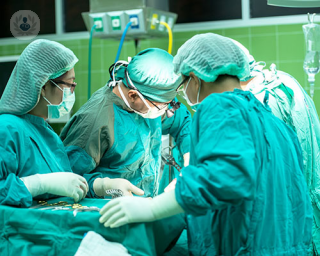Ross procedure
Mr Franco Ciulli - Cardiothoracic surgery
Created on: 11-13-2012
Updated on: 08-15-2023
Edited by: Aoife Maguire
What is the Ross procedure?
The Ross procedure is a surgical procedure used in young people with aortic valve problems. It involves replacing the defective aortic valve with the patient’s own pulmonary valve, and then implanting a cryopreserved pulmonary valve allograft. The Ross procedure is suitable for young people with aortic stenosis or aortic regurgitation that cannot be corrected using conservative techniques. The intervention yields very good results and the patient does not have to take anticoagulants and can lead a completely normal life afterwards.

Why is it done?
The Ross procedure is recommended for patients with certain aortic diseases. It is performed in patients of all ages, from babies to adults aged below 50 years of age, and also in patients with endocarditis of the aortic valve that has not spread to other valves, dysfunction of a bioprosthetic aortic valve, and in young people or sportspeople in whom anticoagulation is contraindicated or who have excellent haemodynamic parameters.
What does the Ross procedure involve?
The procedure involves replacing the defective aortic valve with the patient’s own pulmonary valve; then, implanting a cryopreserved pulmonary valve (obtained from a cadaver) where the patient’s own pulmonary valve was extracted. The advantages of the Ross procedure are that it yields haemodynamics similar to those of the native aortic valve and lifetime anticoagulant therapy is not required. The valve is able to grow, is more resistant to infections than prosthetic valves and does not produce haemolysis (the breakdown of red blood cells).
How to prepare for the Ross procedure
Preparation for this intervention is similar to that for any other surgical procedure. The following are some of the actions that precede a surgical procedure:
- Clinical history: the specialist assesses your clinical history and performs a physical examination.
- Pre-operative tests: generally, blood analysis, coagulation testing, ECG and chest X-rays are taken.
- Provision of information: the surgeon must explain to you in detail the operation that they will perform, associated complications, risks and lasting effects, etc.
- Consent: as the final step, you will sign a document that serves as proof of your consent with regard to the information received.
- Sedatives to help you relax the night before surgery.
- The part of your body to be operated on will be shaved.
- You will receive medications to prevent possible post-operative infections.
- General anaesthesia is administered.
Post-operative care
Follow-up after discharge will consist of a consultation at least once a month. An echocardiogram may be done to evaluate the results of the valve reconstruction; results will be recorded so that changes over time can be seen. In addition, all patients will receive an anti-inflammatory treatment for approximately one month.


